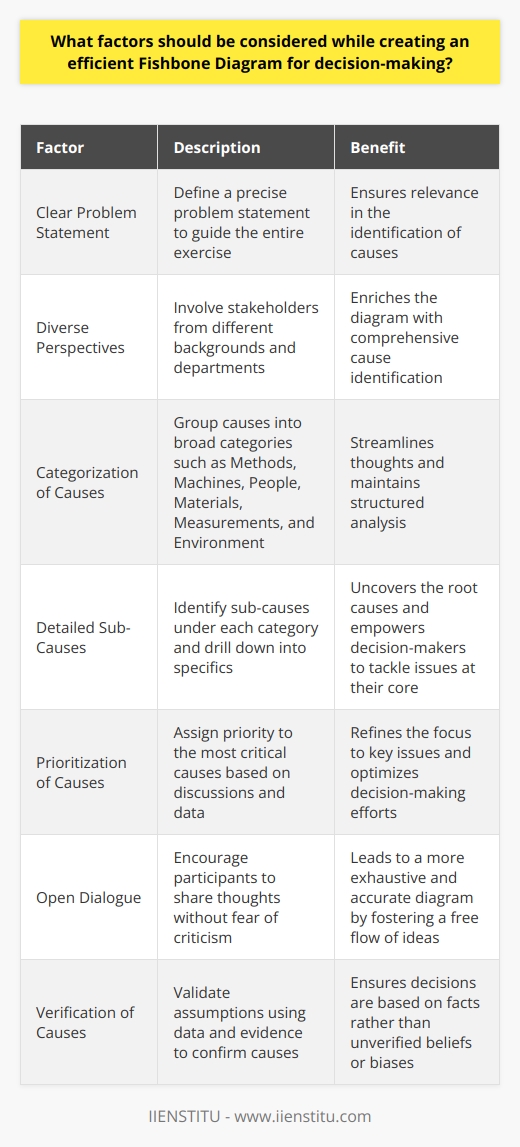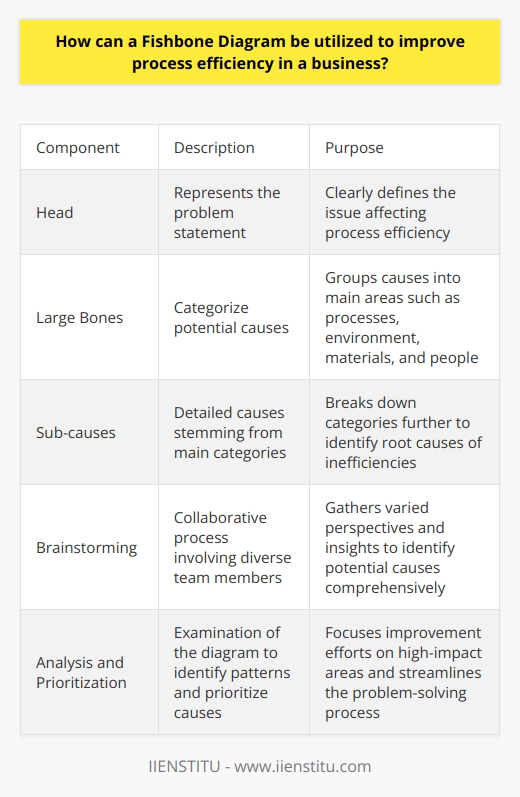
As industries grow increasingly complex and interconnected, the necessity for effective decision-making tools becomes paramount. One such tool that stands as a keystone of organizational problem-solving is the Fishbone Diagram, also known as the Ishikawa or Cause and Effect Diagram.
In a world where identifying the root cause of problems is essential to implement effective solutions, the Fishbone Diagram offers a structured yet simple technique for dissecting issues systematically. The importance of such a diagram rests in its ability to provide a visual map that leads to better understanding, thereby enhancing the problem-solving capabilities within an organization.
The Fishbone Diagram is now a staple in a variety of problem-solving training courses, and its methodologies are often part of the curriculum in online certificate courses related to quality management and process improvement.
The History of the Fishbone Diagram
Origin of the Fishbone Diagram
Dating back to its creation in the 1940s, the Fishbone Diagram was developed by Dr. Kaoru Ishikawa, a Japanese quality control expert, who intended to create a tool that could be used by the engineers in the field to visualize the cause and effect of various problems.
Ishikawa's foundational work in quality management laid the groundwork for modern quality assurance practices, establishing him as a pivotal figure in this domain.
Its evolution over the years
Since its inception, the Fishbone Diagram has undergone various adaptations that have broadened its applicability across numerous sectors.
Its initial use was within the realms of manufacturing and quality control, but as the tool gained recognition, it was adopted by industries like healthcare, marketing, and even education, showcasing its versatility.
How it got its name
The Fishbone Diagram is so-called because its design resembles the skeletal structure of a fish, with a central "spine" and several "bones" branching off. Used for categorizing and visualizing the causes of a specific problem, the diagram facilitates an in-depth analysis that aids in identifying not just the symptoms, but the root causes affecting the system's performance.
Understanding the Fishbone Diagram
Components of a Fishbone diagram
Explanation of the "Head": The "head" of the Fishbone Diagram represents the problem that needs to be addressed. It is the starting point from which all analysis stems, highlighting the end effect that the team wants to dissect.
Explanation of the "Bones": The "bones" extend from the "spine" and represent the main categories of potential causes. These categories are sometimes predetermined as Methods, Machines, Materials, People, Measurements, and Environment, which can then be expanded upon to include specific factors within each category.
Explanation of the "Spine": The "spine" of the diagram provides the structure from which the main categories branch out. Each "bone" on the spine is a line from which further causes can be explored, encouraging the user to dig deeper into each category by asking "Why?" repeatedly.
The principles behind the Fishbone Diagram design
The Fishbone Diagram stands on the principles of organization and clarity. By visually laying out the causes of a problem, it helps to organize thoughts and encourages the team to focus on the broader perspectives of what might be going wrong, rather than jumping to conclusions.
Exploration of the cause and effect relationship in Fishbone Diagram
Through the visual representation, the diagram emphasizes the interconnection between different causes and how they cumulatively lead to a problem. This systematic approach is particularly helpful in identifying non-obvious relationships between the causes and the problems they manifest.
Uses of a Fishbone Diagram
How it aids in identifying potential factors causing an issue
In the complex weave of organizational processes, the Fishbone Diagram serves as a detective's tool, allowing teams to pinpoint potential contributory factors to an issue. By considering each "bone," or category, it prompts teams to look beyond the obvious and consider a wider array of possible sources for the problem.
Its role in facilitating effective brainstorming sessions
Often used in conjunction with brainstorming sessions, the diagram nurtures a comprehensive exploration of the problem at hand. It ensures that every voice is heard and every potential cause is considered, fostering a collaborative environment within teams.
Uses in different industries- with specific examples
In healthcare, for example, a Fishbone Diagram can help in diagnosing patient care issues by looking at the multiple factors affecting patient outcomes. In the automotive industry, it can streamline the manufacturing process by identifying potential causes of defects. Each industry can tailor the categories to fit their specific context, making the Fishbone Diagram a universal tool for issue resolution.
How to Create a Fishbone Diagram
Step by step guide to creating a Fishbone Diagram
Identification of the problem: The first step is to have a clear, concise statement of the problem at hand. This will be placed at the "head" of your fishbone, capturing the essence of what needs to be resolved.
Construction of the "Spine" and "Bones": Following this, participants work out the main categories of causes - the major "bones" - which are connected to the "spine" of the diagram.
Addition and labeling of the causes and sub-causes: The final phase involves drilling down into each category and identifying specific causes - the smaller "bones". These are often determined through a collaborative process, ensuring that a diverse range of perspectives are integrated into the analysis.
Common mistakes to avoid while creating a Fishbone Diagram
It's critical to avoid jumping to conclusions or allowing biases to dictate the categories and causes identified. An unbiased, analytical approach ensures that the Fishbone Diagram fulfills its purpose in unbiased problem analysis.
Limitations and Challenges of a Fishbone Diagram
Discussion on the limitations associated with using a Fishbone Diagram
While the Fishbone Diagram is an invaluable tool, it is not without its limitations. It can become unwieldy if too many causes are included, and it does not provide a direct methodology for prioritizing the identified causes.
Addressing common challenges
To combat the potential complexity, it's advisable to combine the use of a Fishbone Diagram with other analytical tools such as the Pareto chart, which can help prioritize causes. Teams should also be wary of confirmation bias, ensuring that data supports the causes identified on the diagram.
Recap of the major points discussed
The Fishbone Diagram remains an enduring cornerstone of problem-solving, providing a structured means to visually dissect and analyze complex issues. Throughout this article, we have journeyed through its history, understanding, application, creation process, and the limitations that users must be mindful of.
Emphasize the importance of Fishbone Diagram in problem-solving.
In conclusion, the Fishbone Diagram's robust, user-oriented nature continues to facilitate efficient and effective decision-making across myriad industries. Whether it's part of formal problem-solving training courses or an informal tool adopted by a team, its place is well-cemented as an expert approach to tackle the challenges faced in today's fast-paced, solution-oriented workplace environments.
Frequently Asked Questions
What factors should be considered while creating an efficient Fishbone Diagram for decision-making?
Understanding Fishbone Diagrams
To craft an efficient fishbone diagram, one must first comprehend its purpose. This visual tool, also known as an Ishikawa or cause-and-effect diagram, helps pinpoint potential causes of a problem. It aids decision-making by systematically organizing these causes. By doing so, it enhances understanding and fosters informed decisions.
Key Factors for Efficiency
Set a Clear Problem Statement
Start with a precise problem statement. This defines the issue you intend to solve. It guides the entire exercise, ensuring relevance in the identification of causes.
Involve Diverse Perspectives
Analyze the problem from diverse angles. Stakeholders from different backgrounds and departments bring unique insights. This variety enriches the diagram with comprehensive cause identification.
Categorize Potential Causes
Group causes into broad categories. Common categories include Methods, Machines, People, Materials, Measurements, and Environment. These headers help streamline thoughts and maintain structured analysis.
Dive Deeper with Sub-Causes
Identify sub-causes under each category. Drill down into specifics. The more detailed you get, the closer you come to uncovering the root causes. These details empower decision-makers to tackle issues at their core.
Prioritize Identified Causes
Not all causes weigh equally. Assign priority to the most critical ones. Engage in discussions and use data to decide which causes have the greatest impact. This step refines the focus to key issues.
Encourage Open Dialogue
Stimulate open communication among participants. Encourage participants to share thoughts without fear of criticism. A free flow of ideas leads to a more exhaustive and accurate diagram.
Verify Causes
Always validate your assumptions. Use data, where available, to confirm causes. Avoid basing decisions on unverified beliefs or biases. Facts and evidence should underpin the identified causes on the diagram.
Keep it Flexible
Remain adaptable to new information. Be ready to update the fishbone diagram as new insights emerge. Decision-making benefits from responsiveness to evolving understanding.
Review Regularly
Hold review sessions periodically. Revisiting the fishbone diagram ensures it reflects the current state of knowledge. It also allows for adjustments based on implemented decisions and their outcomes.
Final Thoughts
For fishbone diagrams to aid decision-making effectively, clarity, diversity, structure, detail, and verification matter. Entwine these principles with adaptability and continuous improvement. An efficient fishbone diagram thus becomes a dynamic tool. It leads to nuanced understanding and supports stronger, evidence-based decisions.

How can a Fishbone Diagram be utilized to improve process efficiency in a business?
What is a Fishbone Diagram?
A Fishbone Diagram, also known as Ishikawa or cause and effect diagram, serves as a systematic method for examining and portraying the potential causes of a particular problem. Its primary aim involves identifying, exploring, and visually displaying the root causes of issues, leading to process inefficiencies within a business.
The Fishbone Diagram in Detail
The diagram resembles the skeleton of a fish. It starts with a problem statement that is the 'head' of the fish. From there, large 'bones' branch out which categorize potential causes. Causes stem further into detailed sub-causes. This layout fosters in-depth analysis and aids in identifying the root causes.
Utilization for Process Efficiency
Step 1: Define the Problem
Clearly articulate the problem impacting efficiency. Be precise. This accuracy centers the subsequent analysis and ensures relevance.
Step 2: Brainstorm Potential Causes
Gather teams for varied perspectives. Engage in collaborative brainstorming. Identify categories relating to processes, environment, materials, and people.
Step 3: Break Down the Categories
Delve deeper into each category. Ask 'why?' multiple times. This probing finds underlying causes begetting inefficiencies.
Step 4: Analyze and Prioritize Causes
Examine the diagram. Look for patterns and cause-and-effect relationships. Prioritize causes by impact. This focus streamlines the improvement process.
Step 5: Develop Solutions
For each root cause, brainstorm possible solutions. Aim for actionable steps. This change translates analysis into tangible improvements.
Step 6: Implement and Monitor
Put solutions into action. Monitor for effectiveness. Iterate as necessary. This cyclic step ensures adaptive and continuous optimization of processes.
Step 7: Reflect and Refine
After implementation, reflect on the outcomes. Consult the Fishbone Diagram. Refine the process where needed. This reflection stage is crucial for sustained improvement and learning.
Advantages of the Fishbone Diagram
- Encourages thorough examination.
- Fosters teamwork and collective insight.
- Provides a visual summary of complex issues.
- Aids in pinpointing the exact area for improvement.
- Helps avoid tackling symptoms rather than causes.
Conclusion
Fishbone Diagrams offer a structured approach for dissecting and visualizing complexities within business processes. They enhance the problem-solving ability by identifying root causes and formulating targeted solutions. Proper utilization drives efficiency, fosters a culture of continuous improvement, and ultimately contributes to a business’s operational excellence.

What are the common pitfalls to be weary of when implementing a Fishbone Diagram in decision-making prompts?
Understanding Fishbone Diagrams
Fishbone diagrams, also known as Ishikawa diagrams, serve as visual tools. They help untangle complex causality in business processes. Often, teams use them in quality management. Particularly, they aim to pinpoint root causes of defects. Fishbone diagrams resemble the bones of a fish. Hence the name. They stem from the head, which represents the problem in question. From there, they branch into major categories of potential causes.
Pitfalls in Implementation
When implementing fishbone diagrams, vigilance is paramount. Many pitfalls await the unwary. Recognizing these can save time and effort. Here we elaborate on several that decision-makers commonly encounter.
- Overgeneralization can dilapidate a diagram's value. Avoid broad cause categories. They necessitate finer detail. Instead, detail specific process elements.
- Ignoring underlying issues cripples the process. Acknowledge all factors. Do not neglect the small-scale causes. They can aggregate into larger problems.
- Lack of data undermines root cause analysis. Always base causes on evidence. Without data, your hypothesis holds less validity.
- Too many cooks in the brainstorming phase can disorder the process. Limit the group size. Ensure that every member contributes productively.
- Failure to prioritize causes leads to inefficiency. Not every cause warrants the same attention. Prioritize based on impact and likelihood.
- Stopping at symptom level prevents true problem resolution. Dig deeper. Symptoms veil the underlying fundamental causes.
Benefits of Rigorous Application
Meticulous application of fishbone diagrams bears fruit. It illuminates unseen areas of faulty reasoning. Moreover, it fosters a rigorous analytical approach to problem-solving. This is invaluable in corporate decision-making contexts.
A well-constructed fishbone diagram is a masterpiece of clarity. It systematically dissects complex issues. This allows for targeted responses to specific, identified problems. It ensures that solutions address the root causes, not just the superficial symptoms.
Final Thoughts
In conclusion, vigilance and precision are key. They enable the effective use of fishbone diagrams in decision-making. Acknowledge common pitfalls. Strive to avoid them. Doing so will enhance the quality of your analytical processes. Hence, it will lead to smarter, more informed decisions.



